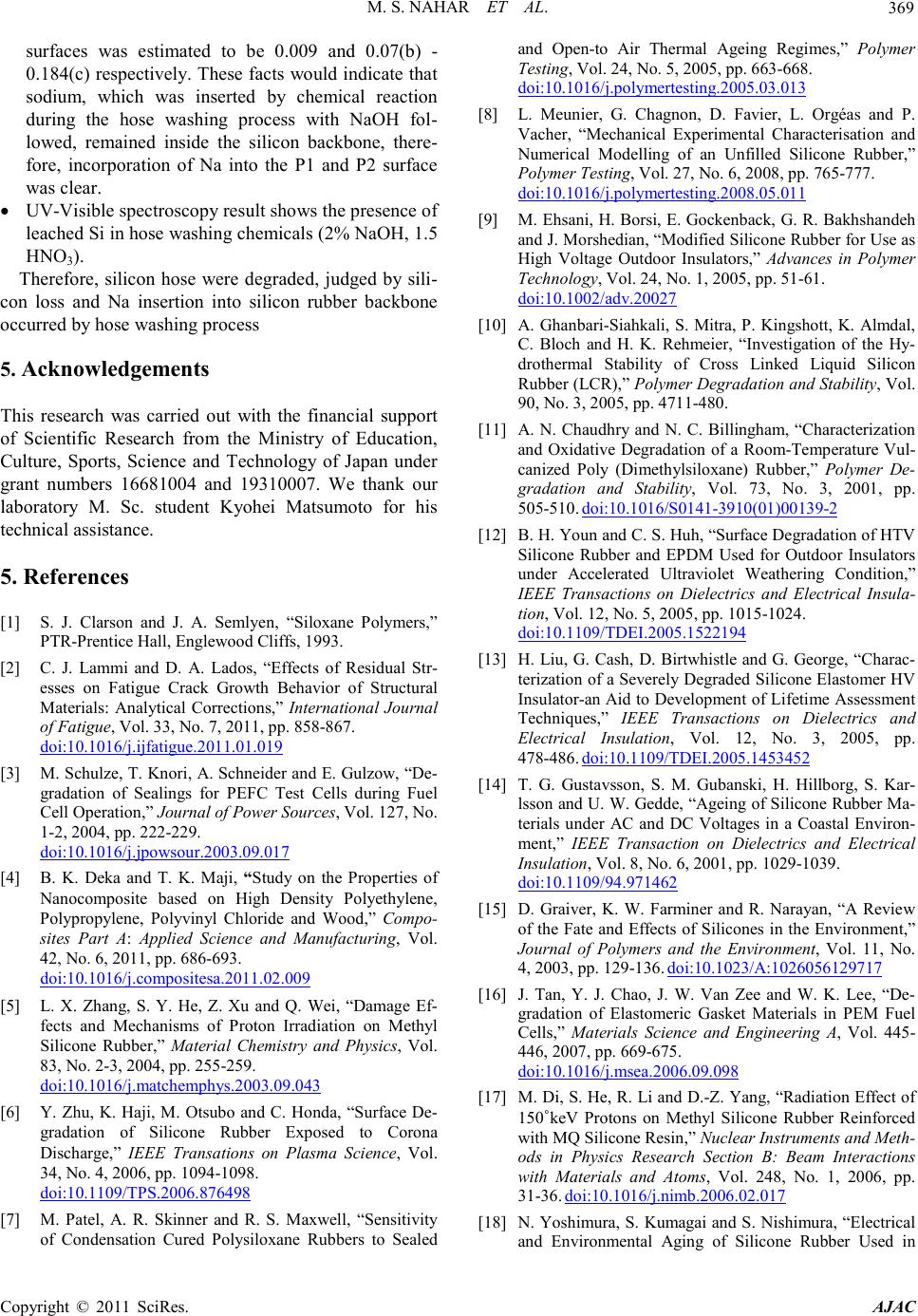
M. S. NAH AR ET AL.
Copyright © 2011 SciRes. AJAC
369
surfaces was estimated to be 0.009 and 0.07(b) -
0.184(c) respectively. These facts would indicate that
sodium, which was inserted by chemical reaction
during the hose washing process with NaOH fol-
lowed, remained inside the silicon backbone, there-
fore, incorporation of Na into the P1 and P2 surface
was clear.
• UV-Visible spectroscopy result shows the presence of
leached Si in hose washing chemicals (2% NaOH, 1.5
HNO3).
Therefore, silicon hose were degraded, judged by sili-
con loss and Na insertion into silicon rubber backbone
occurred by hose washing process
5. Acknowledgements
This research was carried out with the financial support
of Scientific Research from the Ministry of Education,
Culture, Sports, Science and Technology of Japan under
grant numbers 16681004 and 19310007. We thank our
laboratory M. Sc. student Kyohei Matsumoto for his
technical assistance.
5. Referen ces
[1] S. J. Clarson and J. A. Semlyen, “Siloxane Polymers,”
P TR-Prentice Hall, Englewood Cliffs, 1993.
[2] C. J. Lammi and D. A. Lados, “Effects of Residual Str-
esses on Fatigue Crack Growth Behavior of Structural
Materials: Analytical Corrections,” International Journal
of Fatigue, Vo l . 33, No. 7, 20 11 , pp. 85 8-867.
doi:10.1016/j.ijfatigue.2011.01.019
[3] M. Schulze, T. Kn ori, A. Schnei der and E. Gu lz ow, “ De-
gradation of Sealings for PEFC Test Cells during Fuel
Cell Operation,” Journal of Power Sources, Vol. 127, No.
1-2, 2004, pp. 222-229.
doi:10.1016/j.jpowsour.2003.09.017
[4] B. K. Deka and T. K. Maji, “Study on the Properties of
Nanocomposite based on High Density Polyethylene,
Polypropylene, Polyvinyl Chloride and Wood,” Compo-
sites Part A: Applied Science and Manufacturing, Vol.
42, No. 6, 2011, pp. 686-693.
doi:10.1016/j.compositesa.2011.02.009
[5] L. X. Zhang, S. Y. He, Z. Xu and Q. Wei, “Damage Ef-
fects and Mechanisms of Proton Irradiation on Methyl
Silicone Rubber,” Material Chemistry and Physics, Vol.
83, No. 2-3, 2004, pp. 255-259.
doi:10.1016/j.matchemphys.2003.09.043
[6] Y. Zhu, K. Haji, M. Otsubo and C. Honda, “Surface De-
gradation of Silicone Rubber Exposed to Corona
Discharge,” IEEE Transations on Plasma Science, Vol.
34, No. 4, 20 06, pp. 1094-1098.
doi:10.1109/TPS.2006.876498
[7] M. Patel, A. R. Skinner an d R. S. Maxwell, “Sensitivity
of Condensation Cured Polysiloxane Rubbers to Sealed
and Open-to Air Thermal Ageing Regimes,” Polymer
Testing, Vol. 24, No. 5, 2005, pp. 663-668.
doi:10.1016/j.polymertesting.2005.03.013
[8] L. Meunier, G. Chagnon, D. Favier, L. Orgéas and P.
Vacher, “Mechanical Experimental Characterisation and
Numerical Modelling of an Unfilled Silicone Rubber,”
Polymer Testin g, Vol. 27, No. 6, 200 8, pp . 765-777.
doi:10.1016/j.polymertesting.2008.05.011
[9] M. Ehsani, H. Borsi, E. Gockenback, G. R. Bakhshandeh
and J. Morshedian, “Modified Silicone Rubber for Use as
High Voltage Outdoor Insulators,” Advances in Polymer
Technology, Vol. 24, No. 1, 2005, pp. 51-61.
doi:10.1002/adv.20027
[10] A. Ghanbari-Siahkali, S. Mitra, P. Kingshott, K. Almdal,
C. Bloch and H. K. Rehmeier, “Investigation of the Hy-
drothermal Stability of Cross Linked Liquid Silicon
Rubber (LCR),” Pol ymer Degradation and Stability, Vol.
90, No. 3, 20 05, pp. 4711-480.
[11] A. N. Chaudhry and N. C. Billingham, “Characterization
and Oxidative Degradation of a Room-Temperature Vul-
canized Poly (Dimethylsiloxane) Rubber,” Polymer De-
gradation and Stability, Vol. 73, No. 3, 2001, pp.
505-510. doi:10.1016/S0141-3910(01)00139-2
[12] B. H. Youn and C. S. Huh, “Surface Degradation of HTV
Silicone Rubber and EPDM Used for Outdoor Insulators
under Accelerated Ultraviolet Weathering Condition,”
IEEE Transactions on Dielectrics and Electrical Insula-
tion, Vol. 12, No. 5, 20 05, pp. 10 15-1024.
doi:10.1109/TDEI.2005.1522194
[13] H. Liu, G. Cash, D. Birtwhistle and G. George, “Charac-
terizati on of a Severely Degraded Silicone Elastomer HV
Insulator-an Aid to Development of Lifetime Assessment
Techniques,” IEEE Transactions on Dielectrics and
Electrical Insulation, Vol. 12, No. 3, 2005, pp.
478-486. doi:10.1109/TDEI.2005.1453452
[14] T. G. Gustavsson, S. M. Gubanski, H. Hillborg, S. Kar-
lsson and U. W. Gedde, “Ageing of Silicone Rubber Ma-
terials under AC and DC Voltages in a Coastal Environ-
ment,” IEEE Transaction on Dielectrics and Electrical
Insulation, Vol . 8, No. 6, 2001, pp. 1029-1039.
doi:10.1109/94.971462
[15] D. Graiver, K. W. Farminer and R. Narayan, “A Review
of the Fate and Effects of Silicones in the Environment,”
Journal of Polymers and the Environment, Vol. 11, No.
4, 2003, pp. 129-136. doi:10.1023/A:1026056129717
[16] J. Tan, Y. J. Chao, J. W. Van Zee and W. K. Lee, “De-
gradation of Elastomeric Gasket Materials in PEM Fuel
Cells,” Materials Science and Engineering A, Vol. 445-
446, 2007, pp. 669-675.
doi:10.1016/j.msea.2006.09.098
[17] M. Di, S. He, R. Li and D.-Z. Yang, “Radiation Effect of
150˚keV Protons on Methyl Silicone Rubber Reinforced
with MQ Silicone Resin,” Nuclear Instruments and Meth-
ods in Physics Research Section B: Beam Interactions
with Materials and Atoms, Vol. 248, No. 1, 2006, pp.
31-36. doi:10.1016/j.nimb.2006.02.017
[18] N. Yoshimura, S. Kumagai and S. Nishimura, “Electrical
and Environmental Aging of Silicone Rubber Used in